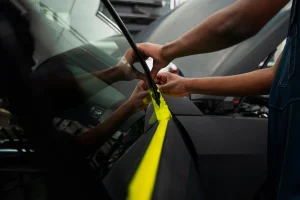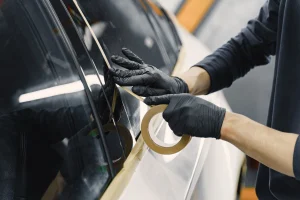What Is Window Tinting? Benefits & Uses Explained
What is Window Tinting?
Table of Contents
 If you are a vehicle owner, you have likely once thought about how to improve your car’s privacy, comfort, and style. One of the most effective upgrades that answers all the mentioned improvements is window tinting, but what is window tinting? Simply answered, window tinting involves the installation of thin, special laminate film onto a vehicle’s window. The film will make the windows darker, yet the perks are much deeper than mere looks.
If you are a vehicle owner, you have likely once thought about how to improve your car’s privacy, comfort, and style. One of the most effective upgrades that answers all the mentioned improvements is window tinting, but what is window tinting? Simply answered, window tinting involves the installation of thin, special laminate film onto a vehicle’s window. The film will make the windows darker, yet the perks are much deeper than mere looks.
Having served thousands of car owners in the Cleveland and Akron areas with 20+ years of experience, we understand the benefits that come with window tinting. A good window tint is an insulating shield blocking solar heat, stopping damage from ultraviolet (UV) rays, and giving privacy.
This guide will answer your question of what window tinting is, how it will improve your car’s resale value, how it works, and what benefits you will experience from the thin laminate that goes on your window.
Why Do People Tint Their Windows?
There are numerous reasons why windows are tinted. It aids with issues that drivers commonly experience, such as hot vehicles, interior material damage, and privacy issues.
- Less Intense Light and Warmth: The greatest advantage is a cooler, more comfortable car interior. Effective window film can reduce the interior temperature by as much as 79%. This enables the owner to use the car air conditioner less, thus conserving fuel.
- UV Protection: And perhaps the greatest health advantage. Regular car glass isn’t completely protective because clear tempered glass allows up to 79% of damaging UVA rays, and we at Nathan’s Detailing use XPEL PRIME XR PLUS film, which offers wonderful SPF 1000 protection, protecting you and your passengers from skin damage.
- Security and Privacy: Tinted film makes car windows obscure, making it harder for random people to see inside.
- Aesthetic appeal: having tinted windows makes your car look sleek and modern, making ordinary cars look like luxury ones; hence, the vehicle will stand out in public.
Don’t settle for inferior films that fade and bubble. Schedule your professional XPEL installation with Nathan’s Detailing and get industry-leading SPF 1000 protection for your family.
Key Terminology Explained
To know what window tinting is, you have to understand some words. These are the key words concerning this subject:
- VLT (Visible Light Transmission): This indicates the percentage of visible light that can pass through the window film. The lower the VLT number, the darker the tint. For instance, a very dark tint known as limo tint has a VLT of 5%, and a very light tint has a VLT of 70%.
- UV Rejection: This indicates the UV ray protection level for film. As noted, quality films like those from XPEL block over 99% of UV rays.
- Infrared Rejection (IRR): Solar heat primarily enters through infrared radiation. High IRR indicates the films are extremely efficient in maintaining the interior cool.
- Ceramic Film: It is a unique film consisting of non-conductive, non-metal ceramic particles. Which block heat and UV rays without interfering with electronic signals such as GPS.
- Dyed Film: This is the lowest-cost type of tint. It contains a layer of dye, absorbing the rays from the sun. It provides you with privacy, blocking a few UV rays, but doesn’t absorb heat well, and over time, turns purple.
- Metallized Film: It contains small pieces of metal, which assist in reflecting heat. It is extremely durable but will interfere with electronic signals.
Common Questions About Window Tinting
As an XPEL Certified Partner with over 1,300 Google reviews, we’ve answered thousands of questions. Here are the most common ones.
How much does it cost to tint car windows?
The price of the window tint varies on several factors, such as vehicle size, film type, and so on. Usually prices range from $99 to $850; however, lower tints, such as dyed ones, range from $275 to $350 for a full vehicle.
Get transparent pricing with no surprises. Contact Nathan’s Detailing for a personalized quote based on your vehicle and film preferences.
How long does window tinting take?
A standard installation can typically require 1.5 to 3 hours. Larger vehicles, such as SUVs, could take longer.
How dark can windows be legally tinted?
State window tint laws are determined individually and can vary considerably. In a majority of states, the legal VLT for the front-side windows is either 35% or 50%. However, rear windows can often be darker. 35% is often a choice for many because it offers a good level of visibility with privacy yet remains legal in the majority of states. It is always best to consult with your local DMV or state law when choosing a level of tint.
Worried about legal compliance? Our experts ensure your tint meets all Ohio regulations. Book your consultation and drive with confidence.
Does window tint block heat and UV rays?
Yes. A good film blocks more than 99% of UV rays, which is the industry standard. In blocking heat, a good film can reduce heat by as much as 79%, maintaining the interior much cooler.
What are 5%, 20%, 35%, and 50% window tints?
These are the VLT’s numbers.
- 5% Tint: This is commonly referred to as limo tint. It is the darkest tint and provides the most privacy. In all states, it is illegal on front windows.
- 20% Tint: It is extremely dark in color and provides privacy.
- 35% Tint: This is the most common option due to its good balance of privacy, style, and visibility.
- 50% Tint: Light shade, still offers good heat and ultraviolet protection, but doesn’t drastically alter the appearance of the window.
What is ceramic vs carbon window tint?
Carbon Tint: It employs carbon particles to achieve a dark, flat appearance. It blocks heat efficiently and won’t deteriorate like a dyed film.
Ceramic Tint: incorporates unique ceramic particles designed specifically to block the hottest heat and infrared light, while not interfering with connections such as GPS
How to apply/remove/clean window tint?
- Although you can purchase DIY kit packages, it is advisable to have it professionally installed to avoid issues such as bubbles, peeling, and dirt.
- To clean: use a non-ammonia cleaner and a soft microfiber cloth.
- To remove the old tint, it is advisable to leave it to a professional to avoid damaging the glass.
What happens if you roll down the windows too soon?
Once you apply it, the film must dry and stick well to the glass. This drying time requires roughly 2 to 4 days. Don’t roll down your windows too soon, as the film could peel off, move, or form bubbles.
Does tint go on inside or outside?
Tints are placed inside the glass. This protects the film from external elements such as weather, road dirt, and car washes.
How long do tints last? What can you do for bubbles or peeling?
How long window tints last depends on film quality and application. Budget films degrade for roughly three years when bubbles form, or the color turns purple. High-quality ceramic films, properly installed, are designed to endure as long as you own a vehicle.
Should you tip your tint installer?
Tipping isn’t necessary, but in the event you are extremely pleased with the service, a tip in the form of 10-20%, as in other professions, is a common means of expression for gratitude.
How to Choose the Right Kind of Window Tint
Choosing the right tint all comes down to your budget and needs.
- To maximize performance and keep away heat from the car, select a ceramic film. It resists UV and infrared heat effectively without impacting electronics.
- If you are looking for something affordable, select a color-dyed film. It provides privacy and protection against ultraviolet rays but doesn’t keep out heat well and doesn’t last as long as other films.
- If you are looking for something in between, carbon film is for you; it’s a good midtier option that won’t fade and provides solid heat protection.
Expert Tips & Common Mistakes
After asking 15+ customers of their previous experiences, the biggest regret they tell us is DIYing the job or choosing a low-quality installer to save a few dollars; other common mistakes include.
- Violating local regulations, which will get you fined and an order for you to remove it.
- Selecting cheap films. Poor-quality films are prone to bubbling and peeling, as well as discoloration, within only a few years.
- poor installation. Bubbles, an uneven pattern, and dust indicate someone installed poorly. A good installer installs properly so it can last for a long time.
Related Services You Might Like
Maintaining your vehicle isn’t only about changing windows. Caring for your whole car keeps your investment safe, so keep in consideration these services to maintain your vehicle in a healthy condition:
- Is ceramic coating worth it? Learn how a ceramic coating provides robust protection for your clear coat, much like a tint for your windows.
- Can you ceramic coat PPF? For maximum protection, find out how installing paint protection film with a ceramic coating provides excellent protection from scratches, chips, and bad weather.
- How to prepare your car for winter: Keep your vehicle in condition regardless of road salt, ice, and rugged winter weather with these handy hints.
- How to remove stains from leather car seats: Maintain the luxury and value of your interior by learning the proper techniques for leather care.
Frequently Asked Questions (FAQ)
What is the main reason for window tints?
The main reason people put tints on their cars is that it rejects over 99% of harmful UV rays and keeps away 86% of roof heat, which in turn makes the vehicle cool, not to forget it diminishes glare and enhances privacy.
Is a 35% window film dark?
A 35 VLT is a medium shade. It is dark enough so people can’t see in from the outside, yet it looks good, and you can see through from inside. making it a legal and popular choice in many states.
How much does professional window tinting cost?
Professional tints can run from $99 to $850. It varies based on film type (dyed, carbon, or ceramic) as well as vehicle size.
Do ceramic tints make a difference?
Yes. More infrared heat is blocked with ceramic tint than with other films, yet it doesn’t make your vehicle very dark. It also doesn’t interfere with any electronic signals.

Nathan Tiber
Mobile Car Detailing
Nathan Tiber began detailing vehicles at the age of 15. He always enjoyed cleaning and making things look new again! As God opened doors, Nathan's hobby evolved into a full time business and a career that he loves and is incredibly passionate about. In Nathan's own words, "I know I’ll never be perfect here on earth, but that’s the goal I strive for on every service I provide."
Share this post!
[wprevpro_usetemplate tid="1"]



